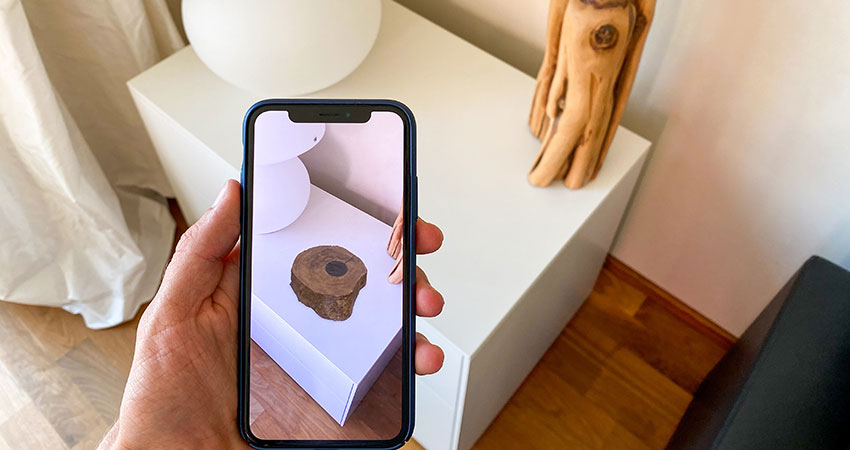Photo credit: UNIBOA on Unsplash
Augmented reality (AR) has come a long way since Pokémon GO made it a household term in 2016. Now the blending of computer-generated images with photos and live views is quickly becoming a standard tool in retailers’ customer experience kits.
In 2020, AR technology was the key to helping customers feel comfortable making high ticket value, customized purchases online, without seeing products in person first. Forrester forecasts that by the end of 2021, up to 48% of consumers in the U.S. will have some experience with AR and virtual reality.
Furniture retailers were among the first to benefit from augmented reality after the pandemic began and showrooms closed or reduced their hours. AR helped these companies overcome logistical and practical challenges in displaying customized products accurately online. For example, a sofa that comes in fifteen different leathers, thirty different fabrics and different leg styles would require a huge amount of time and budget to photograph in every possible option combination.
With AR technology, furniture sellers can artificially generate every combination a shopper might configure and display them immediately. Customers can place them in a photograph of their room or into virtual rooms configured with the same dimensions as their actual room. Augmented reality also lets them add more products to see how they look together and fit into a virtual rendition of their space, and zoom in on 3D AR furniture models for a closer look at the details.
Driving Conversion, Increasing AOV, Lowering Returns
Augmented reality-based product previews have proven especially valuable for high-end furniture retailers that offer customization on items that may cost several thousand dollars apiece. Shoppers looking for these items will hesitate to buy online unless they see the exact combination they want. With AR showing them exactly what they will receive and how it will look and fit in their space, there’s an increase in conversion rates and average order value and a decrease in returns, based on greater confidence in the retailer’s online previews.
These types of AR capabilities have been a game changer for other luxury items, too, including handbags and watches. Without AR previews, many people were uncomfortable buying without seeing them in person. However, when a shopper can upload a picture of their arm and virtually try on different watches, they’re more likely to follow through with a purchase and less likely to return the item.
AR Helps SMBs Separate from Large Competitors
Augmented reality is in a position to become the standard for smaller retailers that want to differentiate themselves from major players. That’s in part because the largest retailers sell so many products that they may not be able to implement AR and VR toolsets any time soon. They also may not need AR capabilities as much, because so many customers are already comfortable buying from them. AR capabilities also enable smaller retailers to replicate the in-store experience online.
You can earn customers’ engagement and trust with AR-driven experiences that show them exactly what they’re buying, increasing confidence and boosting conversion. Retailers and manufacturers can also use AR to enhance the post-purchase experience and differentiate themselves with guided assistance for product assembly, troubleshooting, and simple repairs.
Start With Small Uses Cases and Build
As with any new technology, it’s a good idea to test augmented reality with a small use case first, optimize and expand capabilities to add more features and experiences. Before working on your first AR project, however, review your site performance to ensure that page load times and architecture are optimized. Adding AR features can cause a slow or poorly configured site to perform worse, negatively impacting CX and how search engines prioritize your site.
Make sure the data powering the AR experience is complete, mapped correctly and configured consistently before starting the project, a foundational step. For example, a furniture retailer must have all product dimensions in a well-organized database with a consistent format in order to generate AR versions of customized products. Organizing and cleaning the data upfront can save time and budget on development and deployment.
Typically, you can expect to spend about 12 weeks getting product data, infrastructure and architecture ready to launch your first AR feature, followed by 12 weeks of analyzing and optimizing the new experience, i.e., generating customized 3D images. When that first feature is working well, work on new features and capabilities in three-month blocks, using customer feedback and site metrics to build up a larger suite of AR resources.
AR Experiences Always Evolving
Rolling out features every few months allows for testing and feedback. It also creates a process that’s flexible enough to factor in new innovations along with Voice of the Customer (VoC) data. That’s important because AR and other extended reality technologies are still fairly new.
It’s almost certain that retailers will find new ways to leverage augmented reality, and customer expectations around it will keep evolving. Retailers that adapt along with them will be in the best position to keep delivering the digital shopping experiences customers want.
Aaron Eversoll is Vice President, Commerce and Customer Experience at Capgemini Americas; his co-author is Mike Buob, VP of Experience and Innovation at Sogeti, a unit of Capgemini

